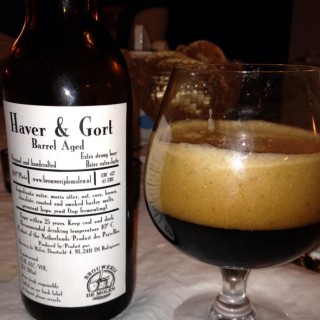Loving beer is hard work, and much of it involves long and tiring hours of sampling shady beers in the company of friends and fellow beergeeks.
With some trepidation we undertook the first what is to become a captilised Grand Tradition: a gathering of geeks, in the pursuit of a greater understanding of beer and all it entails. This first grand occasion we stepped way out of our comfort zone and took on three French beers.
 |
| Parce-que oui nide iou. |
Only marginally generalised, we Belgians consider French beer to be about as drinkable as Dutch beer.
However, turns out there are regions in France which are actually quite renowned for their beers. Not entirely surprisingly, these regions happen to be so close to present-day Belgium that they were once part of historical Flanders.
Bière de Garde is a somewhat amorphously banded style of beer farmhouse ales, relatively quite heavy in terms of alcohol, and centered around a sweet malt base. I'd heard of the style before but it wasn't until I was in France last summer, desperately browsing the stores and supermarkets in search of anything that wasn't either Kronenbourg 1664, Pelforth Brune or the ubiquitous Leffe.
Lo and behold, this is what I found:
 |
| ...in a stylish 50cl boozehead can. |
Surprisingly, I kinda liked this one, and more extensive searching brought up a number of other beers of similar ilk, which the assembled Beer Geeks sat down to sample. All three came in stylish 75cl bottles with a champagne cork; a touch of flair I find quite appealing.
Jenlain then, being the benchmark as far as present-day Bières de Garde are concerned, is an amber beer, surprisingly delicate despite the heavy sweetness of the malty base. My memories of this beer turned out to be somewhat mellowed by long-distant summer days
sur l'herbe, as I quickly grew tired of the monocline sweetness. A beer which needs chilling, and my cellar doesn't have enough power to make this beer really stand out. The assembled Beer Geeks were in agreement: this is not bad, but the Pride of Belgium is under no great threat. Pity, because I really wanted this one to put France on the beer map. Note that the canned beer and the more stylishly presented bottles are the same beer.
Next up was Grain d'Orge from the eponymous Brassier Grain d'Orge, another name of renown where Bières de Gardes are concerned.
"Malt kernel" is as fitting a name as any.
Lighter in colour and leaning towards dark blonde, I found this one to be less balanced and subtle than the Jenlain. Again, by no means a bad beer at all, but decidedly underwhelming, and after the Jenlain, the Grain d'Orge didn't stand a chance.
The last of my summer-stash was the 3 Monts, brewed by the almost-Belgian St-Sylvestre.
Note to Self: find out which three mountains.
Technically this is not a Bière de Garde, albeit only because the label doesn't claim it is one. Bières de Gardes aren't easily classifiable, but generally speaking, this one could be reckoned to be one of them. From my own point of view, I'd categorise it as a very unimpressing tripel-style beer, only with a distinctive absence of spices. What remains is a bit of a musty affair, just on the wrong side of the middle of the road.
The B side then.
As a beer, it's a fine case in the study of tripels, which, when shorn of their curucao peels and coriander notes, become lackluster and a bit bland. As much as I'd wanted to give this nicely packaged bottle a chance, I found it to be dull and slightly unpleasant.
As a genre, if these three examples are anywhere near representative, Bières de Garde are not for everyone. I daresay that the experienced beer afficionado will find them lacking in imagination, and overly focused on sweet malts, and the heavy aromas thereof. Combined with the relatively high ABV (we're talking 8% ABV on average here), these aren't the thirst-quenchers I'd expect a farmhouse ale to be.
To finish the evening on a more uplifting note, we popped a bottle of La Chouffe. Since this is neither a tripel, nor a farmhouse ale, and in fact a little bit of both, it seemed fitting, if not entirely fair: the Ardennian gnome stood out in every aspect, and we didn't really need to read the label to recognise the impartance of spices in beers of this ilk. Anything over 7% ABV needs something, be it yeast, hops, spices or specialty agressive sppecialty malts to offset the stickiness of the heavy wort, and the booziness of the alcohol, and as far as I'm concerned, Bières de Garde fall short of the drinkable mark because of a lack of rounded flavour.
While this was never really a contest between France and Belgium, I can see how France got the reputation most Belgians still credit it with. Just across the border from two of the breweries mentioned is Saison territory, and the other one lies just a cork's throw Flanders proper. The beers however, could hardly be more drastivally different.
Beer Geek Night will continue with another headlight sometime next year.
Until then,
Greetz
Jo



























